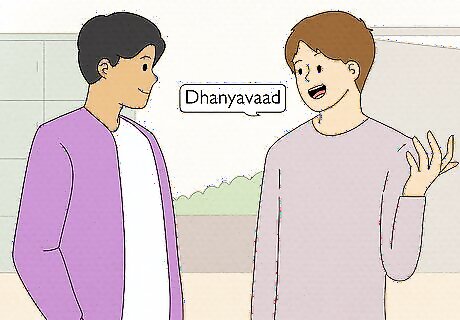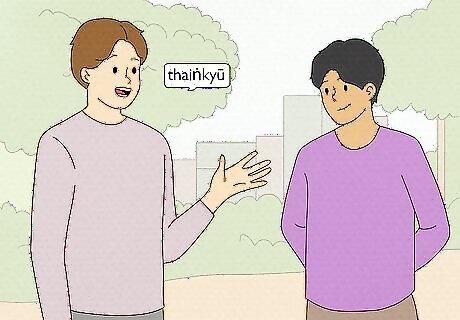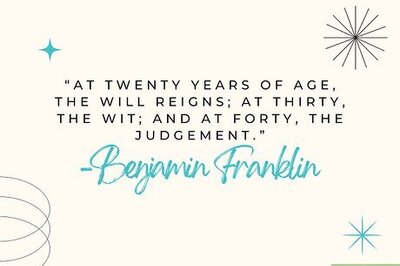
views
- Say “dhanyavaad” (धन्यवाद्), pronounced “dhun-yuh-vahd,” to say “thank you” in formal or business settings and with elders.
- Use “shukriyaa” (शुक्रिया), pronounced “shook-ree-ah,” as an informal “thank you” for friends and family.
- Add “bahut” (बहुत), pronounced “buh-hut,” before “dhanyavaad” or “shukriyaa” to say “thank you very much.”
Formal “Thank Yous”

Use “dhanyavaad” (धन्यवाद्) as a standard, formal “thank you.” This is a common but formal way of saying “thank you.” Say it in situations where you really want to stress your gratitude, like if you've been given a gift. Or, use it with important business contacts, authority figures, and people who are older than you. To speak this in Hindi, pronounce it in three parts: Lay your tongue against the roof of your mouth to pronounce “dha” with a soft “D” sound that's close to the English “dh” sound. Use the short u sound (as in “stuff”). It should sound close to the English word “the” (not like an “ah” sound). Next, say “nyuh” (again, don't use the “ah sound). Last, say “vod.” Here, you will use the “ah” sound. All together, it sounds like “dhun-yuh-vahd.”

Put “bahut” (बहुत) before “dhanyavaad” for “thank you very much.” If you're especially grateful for something, use the superlative “bahut.” This means “very much” or “a lot” and is used the way English speakers might use “very.” This word is pronounced in two parts: First, a short “buh” sound. Next, a more forceful “hut” sound. Put the stress on this part—the whole word sounds like “buh-HUT.” Say “dhanyavaad” after this to complete the phrase (“Bahut dhanyavaad”).

Try “ābhārī hōṅ” (आभारी हुँ) to say “I am grateful.” This is another polite, formal way to say “thank you.” The actual meaning in English is a little closer to “I am grateful.” This word is pronounced in four parts: Say “abb” (rhymes with “rob”). This part isn't pronounced like the English word “ab.” Next, say “ha.” Then, say “ree.” The “R” sound is very similar to the Spanish “R” and should rhyme with “dee” in English. Finish with “hoon” (rhymes with “toon”). All together, it sounds like “abb-ha-ree hoon.”
Informal “Thank Yous”

Use “shukriyaa” (शुक्रिया) as a standard, informal “thank you.” This is a very common way of giving thanks in Hindi used mainly for your friends and family. If you're talking to someone like a boss or teacher, an authority figure, or an elder, use the more formal “dhanyavaad” instead. Pronounce “shukriyaa” in three parts: First, say “shook.” Make this syllable a little shorter and tighter than you'd say the English word. Next, say “ree.” The Hindi “R” sound is a delicate flick of the tongue, like the Spanish “R” sound. This rhymes with “dee.” End with “ah.” The sound is somewhere between “uh” and “ah.” It may take a little practice to get this right. All together, this sounds like “shook-ree-ah.” Nailing the “R” and “D” sounds is important here. Try pronouncing it like “shook-uh-ree-ah,” then gradually shrink the “uh” sound until it's just a flick of the tongue.

Put “bahut” (बहुत) before “shukriyaa” for “thank you very much.” Use “bahut” here to change your basic “thank you” to “thank you very much” or “thanks a lot.” Though you're expressing more gratitude here, this is still considered informal. Bahut is pronounced the same way as in the section above: “buh-HUT.”

Use “thaiṅkyū” (थैंक्यू) if you want to cheat. Hindi, like almost every language, borrows words and phrases from other languages. This Hindi loan word is pronounced exactly like “thank you” in English (because it is English in origin). Because this isn't “pure” Hindi, it's considered less formal than the options in the section above. English is one of the official languages of India, so much of the population will likely be familiar with this phrase even if they don't speak English fluently.
Responding to “Thank You”

Use “svaagat haiṅ” (स्वागत है) for “you're welcome.” When you use any of the “thank you” phrases above, you may get this in return. This phrase means almost exactly “you are welcome.” In fact, you can even say “svaagat” on its own if you're greeting someone who's just arrived (just like you'd use “welcome” in English). To pronounce this phrase: First, say “swah.” This sounds like the English word “swab” without the “b.” Next, say “gut.” Finally, say “hey.” Don't be confused by the “n” in the romanization—this sounds almost exactly like the English word “hey.” All together, sounds like “swah-gut hey.”

Put “āpa kā” (आप का) before “svaagat haiṅ” to say “you are welcome.” The meaning here is not very different from a plain “svaagat haiṅ.” The difference is like saying “you are welcome” versus “you're welcome” (people will react the same way no matter which one you use). Pronounce this phrase in two parts: First, say “aap” (as in “post-op”). Then, say “kuh” (rhymes with “the”). All together, sounds like “aap-kuh.” Follow this with “svaagat haiṅ” for “you are welcome.”

Use “koii baat nahee” (कोई बात नही) for “it's nothing.” This is another way to express that you don't mind doing something for someone else. Use this phrase similarly to how you'd use “don't mention it” or “no problem” in English. This phrase is pronounced in four parts: First, say “coy” (rhyming with the name Zoey). Then, say “baat” (as in “bath”). Next, say a very short “nuh” (rhymes with “the”). End with a longer “hee” (sounds like the English word “he”). Put a little extra stress on this syllable—the last part sounds like “nuh-HEE.” All together, it sounds like “coy baat nuh-HEE.”
















Comments
0 comment